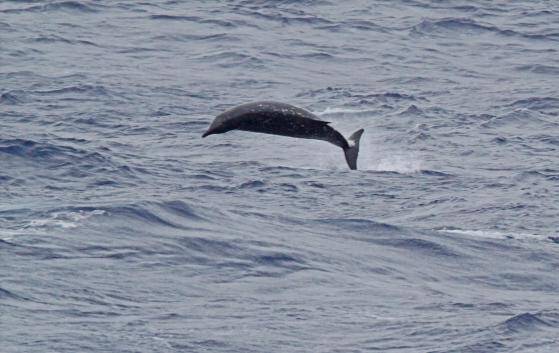Mesoplodon ginkgodens
IUCN
LCBasic Information
Scientific classification
- name:Mesoplodon ginkgodens
- Scientific Name:Japanese beaked whale, Ginkgo beaked whale, Ginkgo-toothed beaked whale
- Outline:Cetacea
- Family:D.whale
Vital signs
- length:4.9-5.9M
- Weight:About 1.5 tons
- lifetime:No verification information
Feature
Adult male whales do not appear to have vertical scars
Distribution and Habitat
Distributed in the temperate and tropical waters of the Pacific and Indian Oceans. From Sri Lanka in the west to the California coast and the Galapagos Islands in North America in the east.
Origin (sea area): American Samoa, Australia, Chile, China, Colombia, Cook Islands, Ecuador, Fiji, French Polynesia, India, Indonesia, Japan, Kenya, Kiribati, Marshall Islands, Mexico, Micronesia, Nauru, New Caledonia, New Zealand, Niue Island, Northern Mariana Islands, Palau, Papua New Guinea, Peru, Philippines, Pitcairn Island, Samoa, Sri Lanka, Tanzania, Tokelau, Tonga, Tuvalu, United States, Minor Outlying Islands of the United States, Vanuatu, Wallis Islands and Futuna Islands.
In China, it is mainly distributed in Liaoning (Zhuanghe), Fujian (Pingtan, Dongshan Wujiao Bay), Taiwan (Pengjia Island, Keelung, Gaoxiong, Xiaoliuqiu Island in Pingtung County), and the east coast of Taiwan (Green Island).
It probably inhabits deep offshore waters and upwelling areas, and is found in tropical
Appearance
The maximum body length of males is 5.9 meters, and that of females is 4.9 meters. The beak is narrow and long, and the lower jaw is slightly longer than the upper jaw. The blowhole is crescent-shaped, with the concave surface facing forward. There is a pair of "V"-shaped throat grooves between the two lower jaws, and the front ends are not connected. The dorsal fin is small and slightly sickle-shaped. The flippers are small and narrow, and can be retracted into the shallow pocket-shaped depression of the human body wall. The tail leaf is large, with a straight rear edge and no notch in the center. The adult male is dark gray, with inconspicuous light spots on the front half of the beak and the lower jaw, no linear scars on the body, and light spots on the ventral side of the back 1/3, with a diameter of about 3 to 4 cm. The upper body of the female is medium gray, and the lower body is light gray. The male whale is uniformly dark all over, and the color will become darker af
Details
Ginkgo-toothed beaked whale (scientific name: Mesoplodon ginkgodens) is called ginkgo-toothed beaked whale in foreign language, and has no subspecies.

Nothing is known about the behavior of the ginkgo-toothed beaked whale, and it should be very cautious by nature. It may appear in small groups. Male beaked whales usually use their protruding teeth to fight and communicate with each other, so males have obvious scars, while females have much fewer scars than males (the number of scars on both sexes is used to assess the level of conflict between beaked whales). Since adult males of this species generally lack long scars (Ginkgo-toothed beaked whales have the fewest scars among beaked whales [5]), Ginkgo-toothed beaked whales are different from other beaked whales and may not fight between males. Little is known about their social structure or behavior, but similar species such as Stejnegeri's beaked whales usually move in groups of 5 to 15.
The diet of Ginkgo-toothed beaked whales is unknown, but it is speculated that they mainly feed on squid and fish in the middle layer of the ocean. Based on the unique bite marks, it is speculated that their main natural enemies are sharks, especially the cigar shark (Isistius brasiliensis).
The reproductive status of the Ginkgo-toothed beaked whale is unknown. Both sexes are estimated to reach sexual maturity at 4.5 meters in length. Newborn calves are about 2 to 2.5 meters long.
There is no estimate of the population abundance of the Ginkgo-toothed beaked whale, and the species is uncommon in any distribution area. Whalers in Japan and Taiwan sometimes kill them with harpoons. Ginkgo-toothed beaked whales are also prone to entanglement in gillnets, especially drift nets in deep waters. There is a lack of reliable research data on this little-known whale to assess its population and future development.
Listed in Appendix II of the Convention on International Trade in Endangered Species of Wild Fauna and Flora (CITES).
Listed in the IUCN Red List of Threatened Species: Data Deficient (DD), assessed in 2008.
Listed in the List of National Key Protected Wildlife in China: National Class II Protected Animal (effective December 10, 1988, Cetacean*Other Cetaceans).
Protect wildlife and stop eating game.
Maintaining ecological balance is everyone's responsibility!








